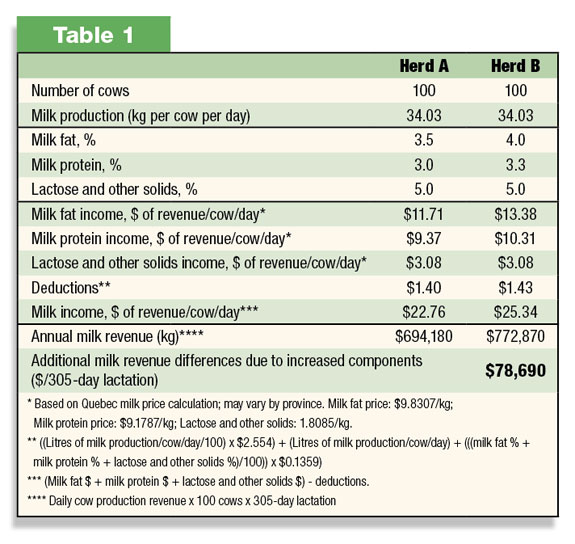One proven way to increase milk check profits is by increasing milk fat and protein levels, resulting in greater returns from the same volume of milk.
Greater profits with greater components
Small improvements in milk component production have the ability to generate additional revenue for the dairy.

The calculations in Table 1 detail the potential financial benefits that can be realized when component levels are boosted.
Based on the component production improvements, Herd B has the ability to generate far greater revenue from the same amount of milk.
Don’t leave profits on the table
Maximizing fat and protein levels can ensure you’re not missing out on profit potential.
The ration is one of the best tools to quickly realize component improvements – in some cases, in only days or weeks – when appropriate changes are made. Use these tips to help maximize components, and ultimately profits, in your herd:
- Measure profit potential with Income Over Feed Cost (IOFC). Producers focused on generating additional revenue have a spectacular opportunity to drive profits higher by focusing on components.
Making the most of your components may mean a greater initial investment in your ration. Rather than focusing on the higher feed costs alone, it’s more important to measure the potential profit a ration change can generate.
A good measure of financial gain is Income Over Feed Cost (IOFC), which accounts for the revenue generated over the feed investment cost.
- Balance rations for dietary cation-anion difference (DCAD). University research has shown that feeding a high-quality potassium carbonate source and raising ration dietary cation-anion difference (DCAD) levels can effectively increase milk fat production in a short period of time.
Cows fed a commercial potassium carbonate produced an additional 0.35 percent (up 0.20 kilograms) fat per cow per day.
- Deliver limiting amino acids for increased protein production. Amino acids are the building blocks of protein, so when they are delivered at optimal levels, component and milk production can be enhanced.
Delivering the two most limiting amino acids – lysine and methionine – in a rumen bypass form helps ensure component production is optimized.
- Test forages frequently. Providing high-quality forages in lactation rations lays the foundation for peak herd performance.
Forage testing measures many important values, including the four macrominerals that are included in the DCAD equation – sodium, potassium, chloride and sulfur.
Because of variability issues, forages can be different from one year to the next or one load to the next. Testing forages must be a top priority to formulate a ration that allows a cow to maximize production and profits.
- Feed high-quality forages. Adding forage to the ration can prevent feeds from quickly passing through the rumen and allow for proper and complete breakdown by rumen bugs to boost volatile fatty acid (VFA) levels. Higher VFA production can translate to greater milk fat in your bulk tank.
- Consult your nutritionist. As crops and ration ingredients vary, your nutritionist can provide solutions to increase and maintain milk component levels utilizing the feeds you have available.
No matter your location, all dairy producers are focused on getting the most from their inputs. By delivering the nutrients cows need to perform optimally, performance and profits can be maximized through both milk and component production. PD
References omitted due to space but are available upon request. Click here to email an editor.

- Elliot Block
- Senior Manager of Technology
- Arm & Hammer Animal Nutrition








